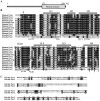Functional redundancy of two Pax-like proteins in transcriptional activation of cyst wall protein genes in Giardia lamblia
- PMID: 22355320
- PMCID: PMC3280250
- DOI: 10.1371/journal.pone.0030614
Functional redundancy of two Pax-like proteins in transcriptional activation of cyst wall protein genes in Giardia lamblia
Abstract
The protozoan Giardia lamblia differentiates from a pathogenic trophozoite into an infectious cyst to survive outside of the host. During encystation, genes encoding cyst wall proteins (CWPs) are coordinately induced. Pax family transcription factors are involved in a variety of developmental processes in animals. Nine Pax proteins have been found to play an important role in tissue and organ development in humans. To understand the progression from primitive to more complex eukaryotic cells, we tried to identify putative pax genes in the G. lamblia genome and found two genes, pax1 and pax2, with limited similarity. We found that Pax1 may transactivate the encystation-induced cwp genes and interact with AT-rich initiatior elements that are essential for promoter activity and transcription start site selection. In this study, we further characterized Pax2 and found that, like Pax1, Pax2 was present in Giardia nuclei and it may specifically bind to the AT-rich initiator elements of the encystation-induced cwp1-3 and myb2 genes. Interestingly, overexpression of Pax2 increased the cwp1-3 and myb2 gene expression and cyst formation. Deletion of the C-terminal paired domain or mutation of the basic amino acids of the paired domain resulted in a decrease of nuclear localization, DNA-binding activity, and transactivation activity of Pax2. These results are similar to those found in the previous Pax1 study. In addition, the profiles of gene expression in the Pax2 and Pax1 overexpressing cells significantly overlap in the same direction and ERK1 associated complexes may phosphorylate Pax2 and Pax1, suggesting that Pax2 and Pax1 may be downstream components of a MAPK/ERK1 signaling pathway. Our results reveal functional redundancy between Pax2 and Pax1 in up-regulation of the key encystation-induced genes. These results illustrate functional redundancy of a gene family can occur in order to increase maintenance of important gene function in the protozoan organism G. lamblia.
Conflict of interest statement
Figures











Similar articles
-
A Novel Multiprotein Bridging Factor 1-Like Protein Induces Cyst Wall Protein Gene Expression and Cyst Differentiation in Giardia lamblia.Int J Mol Sci. 2021 Jan 29;22(3):1370. doi: 10.3390/ijms22031370. Int J Mol Sci. 2021. PMID: 33573049 Free PMC article.
-
A novel pax-like protein involved in transcriptional activation of cyst wall protein genes in Giardia lamblia.J Biol Chem. 2010 Oct 15;285(42):32213-26. doi: 10.1074/jbc.M110.156620. Epub 2010 Aug 10. J Biol Chem. 2010. PMID: 20699219 Free PMC article.
-
Regulation of cyst wall protein promoters by Myb2 in Giardia lamblia.J Biol Chem. 2008 Nov 7;283(45):31021-9. doi: 10.1074/jbc.M805023200. Epub 2008 Sep 3. J Biol Chem. 2008. PMID: 18768462 Free PMC article.
-
[Secreted proteins of Giardia duodenalis--characteristic and role in biology of the parasite].Wiad Parazytol. 2005;51(1):15-9. Wiad Parazytol. 2005. PMID: 16841684 Review. Polish.
-
Mechanisms of adaptation in the intestinal parasite Giardia lamblia.Essays Biochem. 2011;51:177-91. doi: 10.1042/bse0510177. Essays Biochem. 2011. PMID: 22023449 Review.
Cited by
-
A cell-cycle-dependent GARP-like transcriptional repressor regulates the initiation of differentiation in Giardia lamblia.Proc Natl Acad Sci U S A. 2022 May 31;119(22):e2204402119. doi: 10.1073/pnas.2204402119. Epub 2022 May 25. Proc Natl Acad Sci U S A. 2022. PMID: 35613049 Free PMC article.
-
Identification of target genes regulated by encystation-induced transcription factor Myb2 using knockout mutagenesis in Giardia lamblia.Parasit Vectors. 2022 Oct 7;15(1):360. doi: 10.1186/s13071-022-05489-z. Parasit Vectors. 2022. PMID: 36207732 Free PMC article.
-
DNA topoisomerase IIIβ promotes cyst generation by inducing cyst wall protein gene expression in Giardia lamblia.Open Biol. 2020 Feb;10(2):190228. doi: 10.1098/rsob.190228. Epub 2020 Feb 5. Open Biol. 2020. PMID: 32019477 Free PMC article.
-
A Novel Multiprotein Bridging Factor 1-Like Protein Induces Cyst Wall Protein Gene Expression and Cyst Differentiation in Giardia lamblia.Int J Mol Sci. 2021 Jan 29;22(3):1370. doi: 10.3390/ijms22031370. Int J Mol Sci. 2021. PMID: 33573049 Free PMC article.
-
A myeloid leukemia factor homolog is involved in tolerance to stresses and stress-induced protein metabolism in Giardia lamblia.Biol Direct. 2023 Apr 24;18(1):20. doi: 10.1186/s13062-023-00378-6. Biol Direct. 2023. PMID: 37095576 Free PMC article.
References
-
- Ankarklev J, Jerlström-Hultqvist J, Ringqvist E, Troell K, Svärd SG. Behind the smile: cell biology and disease mechanisms of Giardia species. Nat Rev Microbiol. 2010;8:413–422. - PubMed
-
- Robertson LJ, Hanevik K, Escobedo AA, Mørch K, Langeland N. Giardiasis–why do the symptoms sometimes never stop? Trends Parasitol. 2010;26:75–82. - PubMed
-
- Stark D, van Hal S, Marriott D, Ellis J, Harkness J. Irritable bowel syndrome: a review on the role of intestinal protozoa and the importance of their detection and diagnosis. Int J Parasitol. 2007;37:11–20. - PubMed
Publication types
MeSH terms
Substances
LinkOut - more resources
Full Text Sources
Molecular Biology Databases
Miscellaneous

